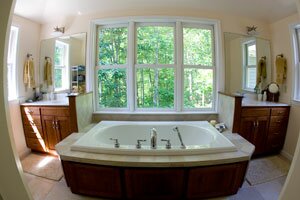SPECIAL GREEN- Gimme shelter: How green was my alley?

Ryan Jacoby
FILE PHOTO
Q: They say you can't teach old dogs new tricks, but my wife and I want to start doing what's right for the environment at home. We hear all this talk about "green" building practices, but aren't sure where to start. What does it really mean to "go green"?
A: In general, "going green" means looking at the big picture. According to the U.S. Green Building Council, our houses use 36 percent of our total energy and 65 percent of our total electricity. By "going green," you join a growing number of people who understand that conserving energy and protecting the health of our environment involves improving those numbers.
Everything is interconnected. For example, you could have an HVAC system that's super efficient, but if mold gets into your ducts, it's going to make things worse. If you live in a wholly traditional structure, applying any one green principle will help, but "going green" really means changing how you maintain your entire household.
There are four general things to focus on: energy efficiency, indoor air quality, types of building and cleaning materials, and waste.
With both materials and cleaners, you want to make sure they have no volatile organic compounds (VOCs) that can be harmful to your health and the environment. You know that "new carpet" smell? Well, that's really off-gassing of VOCs. When choosing products, look into how materials– like a traditional flooring product– are "harvested" and delivered.
You need to think about the "embodied energy" that went into creating the material– that is, all the different processes that went into making it, even delivering it to your door. This way, you can go green simply by choosing materials that are made, processed, and delivered by companies that have gone green. Of course, you'll also want to use materials that can be recycled and reused in different applications. For help evaluating materials, we have two excellent local resources: the GreenBlue Institute (greenblue.org) and also the work of architect Bill McDonough (mcdonough.com).
In examining indoor air quality, you want to consider air flow, contaminants in the air, and controlling mold spores. Are you refreshing your house with fresh air? For more information and resources, you can go online and check out the EPA and OSHA websites, and there's also a group called the Indoor Air Quality Association (iaqa.org).
Energy efficiency uses mechanical systems– like appliances, lighting, heat pumps– that operate efficiently. For example, it's not always best to buy a big heat pump because it heats up/cools your home too quickly, shuts off, then has to start up again. Think about using lighting and appliances that are EnergyStar rated. Using the proper insulation, and sealing your windows and doors will also help.
You can even save energy by landscaping the right way: planting trees and shrubs that block the sun at certain times, and landscaping to conserve and reuse water runoff.
Houses in the U.S. generate 30 percent of the nation's waste, 136 million tons annually, so it's also a good idea to think about what you can reduce or reuse before you dispose.
At the Habitat Store, as part of our "Green Matters" initiative, we are holding workshops on green building principles over the next two years, on everything from conserving water and taking advantage of special tax credits, to reducing your waste output and choosing healthy building materials and cleaning products.
For more information, contact the Habitat Store at 434-293-6331 or check the schedule of workshops at greenmatters.info.
#